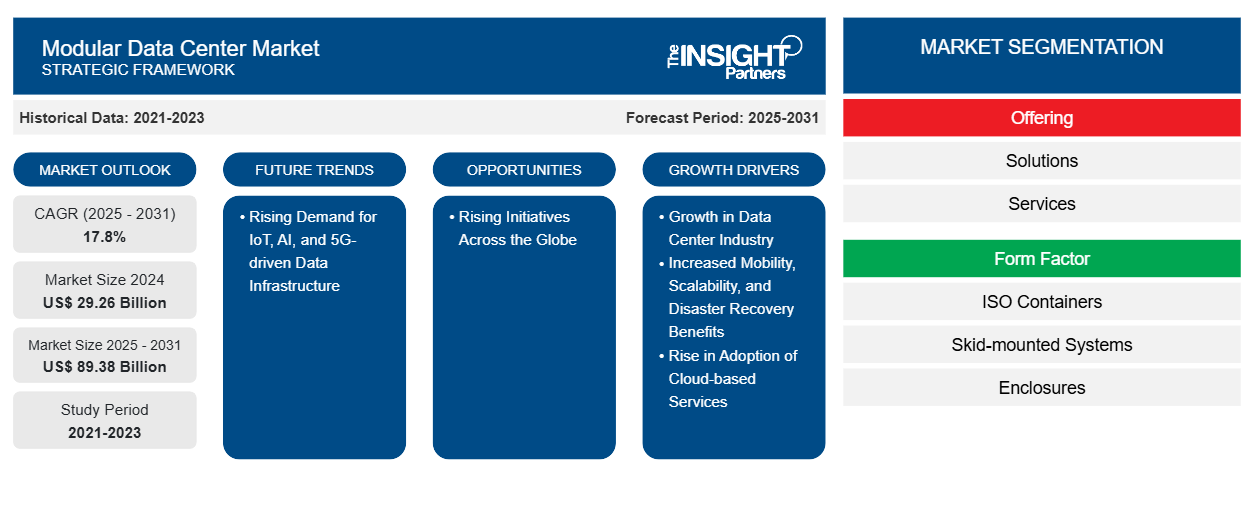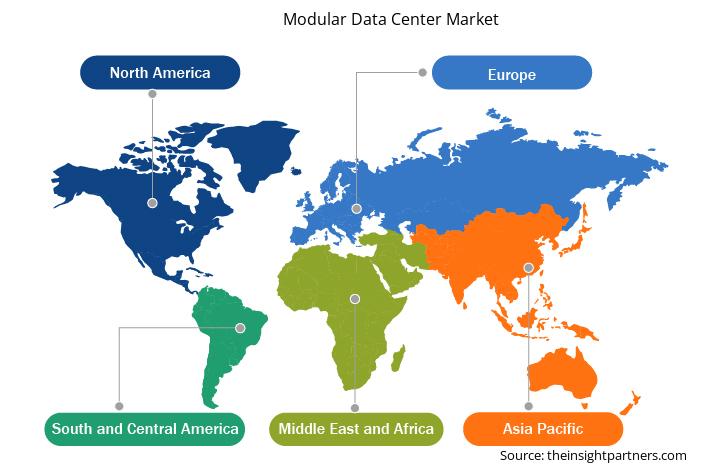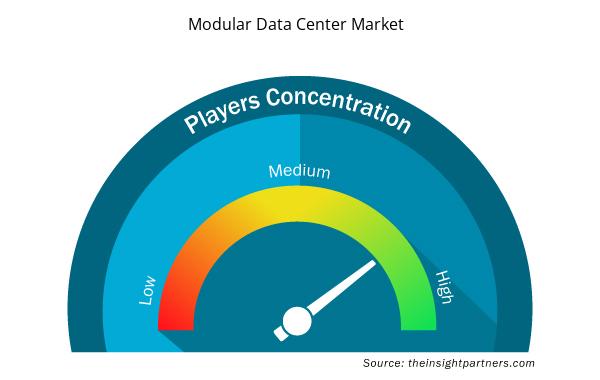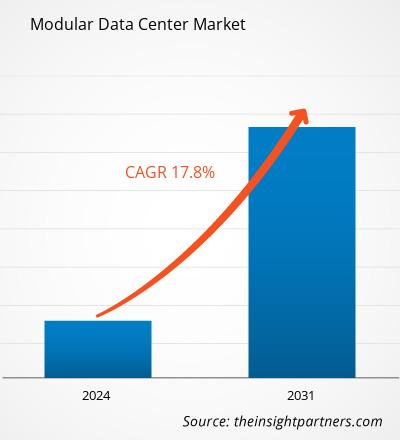El tamaño del mercado de centros de datos modulares se valoró en 29.260 millones de dólares estadounidenses en 2024 y se prevé que alcance los 89.380 millones de dólares estadounidenses para 2031; se estima que registrará una tasa de crecimiento anual compuesta (TCAC) del 17,8 % entre 2025 y 2031. Es probable que la creciente demanda de infraestructura de datos basada en IoT, IA y 5G sea una tendencia clave en el mercado durante el período de pronóstico.
Análisis del mercado de centros de datos modulares
El crecimiento del mercado global de centros de datos modulares se ha visto impulsado por sus ventajas en movilidad, escalabilidad y recuperación ante desastres. Estas innovaciones están diseñadas para ofrecer soluciones rápidas y flexibles, permitiendo a las empresas implementar sistemas de TI. Las organizaciones requieren garantía de continuidad operativa y capacidad de recuperación ante posibles interrupciones. El mercado ofrece diversas soluciones con estructuras robustas que se pueden reubicar o ampliar fácilmente para satisfacer las necesidades específicas de cada empresa. Esta flexibilidad es crucial para mantener la continuidad del negocio durante desastres u otros eventos imprevistos, garantizando la protección de sus datos y aplicaciones.
Descripción general del mercado de centros de datos modulares
Un centro de datos modular es un enfoque escalable y flexible para la gestión de la infraestructura de TI, donde los componentes o módulos individuales son unidades prefabricadas y prediseñadas que se pueden ensamblar y ampliar según sea necesario. A diferencia de los centros de datos tradicionales, que requieren grandes proyectos de construcción centralizados, los centros de datos modulares se construyen utilizando unidades estandarizadas que se pueden implementar y personalizar rápidamente. Esta modularidad permite a las empresas añadir más capacidad con el tiempo sin interrupciones significativas ni grandes inversiones iniciales. Los centros de datos modulares ofrecen varias ventajas clave. Proporcionan escalabilidad, lo que permite a las empresas aumentar su capacidad de procesamiento de datos según sus crecientes necesidades. Esto los hace especialmente valiosos para empresas con un rápido crecimiento o una demanda fluctuante. El diseño modular también garantiza que las empresas puedan ampliar su infraestructura de TI de forma gradual, minimizando costes innecesarios y evitando el sobreaprovisionamiento. La demanda de soluciones flexibles y portátiles aumenta a medida que las empresas se esfuerzan por adaptarse a las cambiantes necesidades del mercado. Los centros de datos modulares permiten a las empresas ampliar su infraestructura según sea necesario, con menos tiempo de inactividad en comparación con los centros de datos tradicionales. Esta flexibilidad es especialmente ventajosa para sectores como el comercio minorista, donde la demanda fluctúa, o para empresas que entran en nuevos mercados. Como la flexibilidad y la respuesta rápida se están volviendo esenciales para el éxito empresarial, los centros de datos modulares se consideran cada vez más como activos valiosos que ayudan a las organizaciones a enfrentar desafíos de manera eficaz y optimizar sus operaciones.
Personalice este informe según sus necesidades
Obtendrá personalización en cualquier informe, sin cargo, incluidas partes de este informe o análisis a nivel de país, paquete de datos de Excel, así como también grandes ofertas y descuentos para empresas emergentes y universidades.
Mercado de centros de datos modulares: perspectivas estratégicas

- Obtenga las principales tendencias clave del mercado de este informe.Esta muestra GRATUITA incluirá análisis de datos, desde tendencias del mercado hasta estimaciones y pronósticos.
Impulsores y oportunidades del mercado de centros de datos modulares
Crecimiento de la industria de los centros de datos
La industria de los centros de datos ha experimentado un crecimiento significativo durante la última década, impulsado por el aumento del consumo de datos, la adopción de la nube y la proliferación de dispositivos IoT. Según JLL, en septiembre de 2024, la industria de los centros de datos experimentará una demanda abrumadora por parte de los usuarios. A mediados de 2024, la capacidad disponible de centros de datos de coubicación en EE. UU. alcanzó los 12 GW, habiéndose duplicado desde 2020, con una tasa de crecimiento anual compuesta del 21 %. El norte de Virginia sigue liderando el mercado más grande, representando casi la mitad de la expansión de capacidad desde 2020 y superando a otras regiones por un margen significativo. Sin embargo, los mercados del sur y el oeste de EE. UU. han experimentado un crecimiento más rápido. A medida que las organizaciones y empresas continúan expandiendo su infraestructura digital, la necesidad de una gestión eficiente y confiable de sistemas de TI complejos se ha intensificado. Esto ha dado lugar a la creciente demanda de centros de datos modulares, que desempeñan un papel fundamental para permitir una gestión fluida de las operaciones de los centros de datos.
Aumento en la adopción de servicios basados en la nube
Los gobiernos y las grandes empresas están priorizando la implementación de soluciones y aplicaciones avanzadas en la nube . Los principales actores de la industria se están enfocando en desarrollar centros de datos modulares de vanguardia equipados con tecnologías inmersivas para administrar grandes cantidades de datos. Por ejemplo, en julio de 2025, Vertiv, líder mundial en infraestructura digital crítica y soluciones de continuidad, presentó Vertiv MegaMod CoolChip, una solución de centro de datos modular prefabricada (PFM) equipada con refrigeración líquida, diseñada para soportar una computación de IA eficiente y confiable . Esta solución puede personalizarse para acomodar plataformas de los principales proveedores de computación de IA y escalarse según las necesidades del cliente. Al combinar el enfoque de alta calidad y eficiencia de procesos de la fabricación externa con tecnologías avanzadas listas para IA, MegaMod CoolChip puede reducir el tiempo de implementación para la infraestructura digital crítica para IA hasta en un 50%.
Análisis de segmentación del informe de mercado de centros de datos modulares
Los segmentos clave que contribuyeron a la derivación del análisis del mercado del centro de datos modular son la oferta, las soluciones, el factor de forma, el tamaño de la organización y la vertical de la industria.
- En términos de oferta, el mercado se bifurca en soluciones y servicios.
- Según las soluciones, el mercado está segmentado en módulos prefabricados y soluciones todo en uno.
- En términos de factor de forma, el mercado se divide en contenedores ISO, sistemas montados sobre patines y gabinetes.
- Según el tamaño de la organización, el mercado se bifurca en PYMES y grandes empresas.
- Por sector industrial vertical, el mercado se divide en TI y telecomunicaciones, BFSI, gobierno, atención médica, manufactura, medios y entretenimiento, y otros.
Análisis de la cuota de mercado de los centros de datos modulares por geografía
- El mercado de centros de datos modulares se segmenta en cinco regiones principales: Norteamérica, Europa, Asia Pacífico (APAC), Oriente Medio y África (MEA), y Sudamérica y Centroamérica. Norteamérica dominó el mercado en 2024, seguida de Europa y Asia Pacífico.
- El mercado de centros de datos modulares en Norteamérica está segmentado en EE. UU., Canadá y México. La rápida expansión de las aplicaciones con uso intensivo de datos y la computación en la nube ha resultado en un aumento considerable en el número de centros de datos en la región. Según el Análisis de Tendencias de Centros de Datos de Norteamérica de CBRE de 2024, los siete principales mercados de centros de datos en Norteamérica operan en EE. UU., es decir, en el norte de Virginia, Dallas/Fort Worth, Silicon Valley, Chicago, Phoenix, el área triestatal de Nueva York y Atlanta. La rápida adopción de las tecnologías de computación en la nube, IoT, IA y 5G está impulsando la demanda de centros de datos escalables y eficientes en Norteamérica. Estas tecnologías requieren una infraestructura robusta, flexible y confiable, lo que convierte a los centros de datos modulares en una solución ideal. Los centros de datos modulares brindan la escalabilidad necesaria para acomodar los crecientes volúmenes de datos, lo que permite a las empresas ampliar su infraestructura rápidamente para satisfacer las demandas cambiantes.
- La necesidad de procesamiento de datos localizado y de baja latencia se vuelve cada vez más crítica, especialmente con el auge del IoT y las aplicaciones de datos en tiempo real. Los centros de datos modulares ofrecen una solución que permite a las empresas implementar unidades más pequeñas y distribuidas geográficamente que reducen la latencia y mejoran el rendimiento. Esto es especialmente importante en sectores como el automotriz, el sanitario y el manufacturero, donde el procesamiento de datos en tiempo real es crucial para la eficiencia operativa. De igual manera, la creciente tendencia de la computación en el borde de la red en Norteamérica es un factor clave para la adopción de centros de datos modulares. A medida que las empresas buscan una mayor potencia de procesamiento más cerca de la fuente de generación de datos, los centros de datos modulares ofrecen la flexibilidad y la rápida implementación necesarias para las aplicaciones de computación en el borde de la red.
- Vertiv Group, Schneider Electric y Emerson son algunas de las empresas líderes en el mercado europeo de centros de datos modulares. Estos inversores están implementando diversas iniciativas para el desarrollo de centros de datos modulares. En noviembre de 2024, Schneider Electric, líder en la transformación digital de la gestión y automatización energética, amplió significativamente la capacidad de fabricación y producción de su fábrica de centros de datos prefabricados de Barcelona, incrementándola de 7.000 m² a 12.000 m² en respuesta a la creciente demanda de soluciones prefabricadas para centros de datos con alta carga de trabajo. La fábrica y el gran centro logístico, ubicados en Sant Boi de Llobregat (Barcelona), uno de los principales centros de Europa para el diseño, la producción y la integración de la cartera de centros de datos modulares EcoStruxure de Schneider Electric, proporcionan 5.000 m² adicionales de espacio dedicado a la producción, lo que satisface las crecientes necesidades de los clientes en cuanto a rapidez de comercialización, previsibilidad y soluciones resilientes para centros de datos.
Perspectivas regionales del mercado de centros de datos modulares
Los analistas de Insight Partners han explicado detalladamente las tendencias y los factores regionales que influyen en el mercado de centros de datos modulares durante el período de pronóstico. Esta sección también analiza los segmentos y la geografía del mercado de centros de datos modulares en Norteamérica, Europa, Asia Pacífico, Oriente Medio y África, y Sudamérica y Centroamérica.

- Obtenga los datos regionales específicos para el mercado de centros de datos modulares
Alcance del informe de mercado de centros de datos modulares
| Atributo del informe | Detalles |
|---|---|
| Tamaño del mercado en 2024 | US$ 29.26 mil millones |
| Tamaño del mercado en 2031 | US$ 89.38 mil millones |
| CAGR global (2025-2031) | 17,8% |
| Datos históricos | 2021-2023 |
| Período de pronóstico | 2025-2031 |
| Segmentos cubiertos | Ofreciendo
|
| Regiones y países cubiertos | América del norte
|
| Líderes del mercado y perfiles de empresas clave |
|
Densidad de actores del mercado de centros de datos modulares: comprensión de su impacto en la dinámica empresarial
El mercado de centros de datos modulares está creciendo rápidamente, impulsado por la creciente demanda de los usuarios finales debido a factores como la evolución de las preferencias de los consumidores, los avances tecnológicos y un mayor conocimiento de las ventajas del producto. A medida que aumenta la demanda, las empresas amplían su oferta, innovan para satisfacer las necesidades de los consumidores y aprovechan las tendencias emergentes, lo que impulsa aún más el crecimiento del mercado.
La densidad de actores del mercado se refiere a la distribución de empresas o compañías que operan en un mercado o sector en particular. Indica cuántos competidores (actores del mercado) hay en un mercado determinado en relación con su tamaño o valor total.
Las principales empresas que operan en el mercado de centros de datos modulares son:
- Schneider Electric SE
- PCX Holding LLC
- Huawei Digital Power Technologies Co. Ltd.
- Delta Electronics Inc
- Rittal GmbH & Co. KG
- Eaton Corp Plc
Descargo de responsabilidad : Las empresas enumeradas anteriormente no están clasificadas en ningún orden particular.

- Obtenga una descripción general de los principales actores clave del mercado de centros de datos modulares
Noticias y desarrollos recientes del mercado de centros de datos modulares
El mercado de centros de datos modulares se evalúa mediante la recopilación de datos cualitativos y cuantitativos tras la investigación primaria y secundaria, que incluye importantes publicaciones corporativas, datos de asociaciones y bases de datos. A continuación, se enumeran algunos de los avances en el mercado de centros de datos modulares:
- Eaton y CTS Nordics, empresa que diseña y construye centros de datos, están construyendo una nueva planta NordicEPOD en Oslo. La moderna planta de NordicEPOD produce módulos de potencia estandarizados, conocidos como EPOD, que reducen el tiempo de construcción del centro de datos en semanas.
(Fuente: Eaton, comunicado de prensa, 2025)
- Schneider Electric, líder mundial en la transformación digital de la gestión de la energía y la automatización, inauguró una nueva instalación de integración de 105.000 pies cuadrados en Red Oak, Texas, que se utilizará para construir infraestructura modular prefabricada para satisfacer la creciente demanda de nuevos centros de datos en todo Estados Unidos.
(Fuente: Schneider Electric, Nota de prensa, 2024)
Informe de mercado de centros de datos modulares: cobertura y resultados
El informe "Tamaño y pronóstico del mercado de centros de datos modulares (2021-2031)" ofrece un análisis detallado del mercado que abarca las siguientes áreas:
- Tamaño del mercado de centros de datos modulares y pronóstico a nivel global, regional y nacional para todos los segmentos clave del mercado cubiertos bajo el alcance
- Tendencias del mercado de centros de datos modulares, así como dinámicas del mercado como impulsores, restricciones y oportunidades clave
- Análisis PEST y FODA detallado
- Análisis del mercado de centros de datos modulares que abarca las tendencias clave del mercado, el marco global y regional, los principales actores, las regulaciones y los desarrollos recientes del mercado.
- Análisis del panorama industrial y de la competencia que abarca la concentración del mercado, el análisis de mapas de calor, los actores destacados y los desarrollos recientes para el mercado de centros de datos modulares.
- Perfiles detallados de empresas
- Análisis histórico (2 años), año base, pronóstico (7 años) con CAGR
- Análisis PEST y FODA
- Tamaño del mercado Valor/volumen: global, regional, nacional
- Industria y panorama competitivo
- Conjunto de datos de Excel


- Drain Cleaning Equipment Market
- Bathroom Vanities Market
- Sandwich Panel Market
- Print Management Software Market
- Vaginal Specula Market
- Health Economics and Outcome Research (HEOR) Services Market
- Emergency Department Information System (EDIS) Market
- Predictive Maintenance Market
- Thermal Energy Storage Market
- Small Internal Combustion Engine Market

Report Coverage
Revenue forecast, Company Analysis, Industry landscape, Growth factors, and Trends

Segment Covered
This text is related
to segments covered.

Regional Scope
North America, Europe, Asia Pacific, Middle East & Africa, South & Central America

Country Scope
This text is related
to country scope.
Preguntas frecuentes
The key players, holding majority shares, in modular data center market includes Huawei Technologies Co., Ltd., Dell Inc., Schneider Electric, Hewlett Packard Enterprise Development LP, and ABB Ltd.
The North America held the largest market share in 2024, followed by Europe.
The modular data center market was valued at US$ 29.25 billion in 2024 and is projected to reach US$ 89.37 billion by 2031; it is expected to grow at a CAGR of 17.8% during 2025–2031.
Growth in data center industry and increased mobility, scalability, and disaster recovery benefits, and rise in adoption of cloud-based services are the driving factors impacting the modular data center market.
Rising Demand for IoT, AI, and 5G-driven Data Infrastructure is the future trends of the modular data center market.
The modular data center market is expected to reach US$ 89.37 billion in the year 2031.
Trends and growth analysis reports related to Technology, Media and Telecommunications : READ MORE..
The List of Companies - Modular Data Center Market
- Schneider Electric SE
- PCX Holding LLC
- Huawei Digital Power Technologies Co Ltd
- Delta Electronics Inc
- Rittal GmbH & Co KG
- Eaton Corp Plc
- Dell Technologies Inc
- Vertiv Group Corp.
- Hewlett Packard Enterprise Development LP
- ABB Ltd
The Insight Partners performs research in 4 major stages: Data Collection & Secondary Research, Primary Research, Data Analysis and Data Triangulation & Final Review.
- Data Collection and Secondary Research:
As a market research and consulting firm operating from a decade, we have published and advised several client across the globe. First step for any study will start with an assessment of currently available data and insights from existing reports. Further, historical and current market information is collected from Investor Presentations, Annual Reports, SEC Filings, etc., and other information related to company’s performance and market positioning are gathered from Paid Databases (Factiva, Hoovers, and Reuters) and various other publications available in public domain.
Several associations trade associates, technical forums, institutes, societies and organization are accessed to gain technical as well as market related insights through their publications such as research papers, blogs and press releases related to the studies are referred to get cues about the market. Further, white papers, journals, magazines, and other news articles published in last 3 years are scrutinized and analyzed to understand the current market trends.
- Primary Research:
The primarily interview analysis comprise of data obtained from industry participants interview and answers to survey questions gathered by in-house primary team.
For primary research, interviews are conducted with industry experts/CEOs/Marketing Managers/VPs/Subject Matter Experts from both demand and supply side to get a 360-degree view of the market. The primary team conducts several interviews based on the complexity of the markets to understand the various market trends and dynamics which makes research more credible and precise.
A typical research interview fulfils the following functions:
- Provides first-hand information on the market size, market trends, growth trends, competitive landscape, and outlook
- Validates and strengthens in-house secondary research findings
- Develops the analysis team’s expertise and market understanding
Primary research involves email interactions and telephone interviews for each market, category, segment, and sub-segment across geographies. The participants who typically take part in such a process include, but are not limited to:
- Industry participants: VPs, business development managers, market intelligence managers and national sales managers
- Outside experts: Valuation experts, research analysts and key opinion leaders specializing in the electronics and semiconductor industry.
Below is the breakup of our primary respondents by company, designation, and region:

Once we receive the confirmation from primary research sources or primary respondents, we finalize the base year market estimation and forecast the data as per the macroeconomic and microeconomic factors assessed during data collection.
- Data Analysis:
Once data is validated through both secondary as well as primary respondents, we finalize the market estimations by hypothesis formulation and factor analysis at regional and country level.
- Macro-Economic Factor Analysis:
We analyse macroeconomic indicators such the gross domestic product (GDP), increase in the demand for goods and services across industries, technological advancement, regional economic growth, governmental policies, the influence of COVID-19, PEST analysis, and other aspects. This analysis aids in setting benchmarks for various nations/regions and approximating market splits. Additionally, the general trend of the aforementioned components aid in determining the market's development possibilities.
- Country Level Data:
Various factors that are especially aligned to the country are taken into account to determine the market size for a certain area and country, including the presence of vendors, such as headquarters and offices, the country's GDP, demand patterns, and industry growth. To comprehend the market dynamics for the nation, a number of growth variables, inhibitors, application areas, and current market trends are researched. The aforementioned elements aid in determining the country's overall market's growth potential.
- Company Profile:
The “Table of Contents” is formulated by listing and analyzing more than 25 - 30 companies operating in the market ecosystem across geographies. However, we profile only 10 companies as a standard practice in our syndicate reports. These 10 companies comprise leading, emerging, and regional players. Nonetheless, our analysis is not restricted to the 10 listed companies, we also analyze other companies present in the market to develop a holistic view and understand the prevailing trends. The “Company Profiles” section in the report covers key facts, business description, products & services, financial information, SWOT analysis, and key developments. The financial information presented is extracted from the annual reports and official documents of the publicly listed companies. Upon collecting the information for the sections of respective companies, we verify them via various primary sources and then compile the data in respective company profiles. The company level information helps us in deriving the base number as well as in forecasting the market size.
- Developing Base Number:
Aggregation of sales statistics (2020-2022) and macro-economic factor, and other secondary and primary research insights are utilized to arrive at base number and related market shares for 2022. The data gaps are identified in this step and relevant market data is analyzed, collected from paid primary interviews or databases. On finalizing the base year market size, forecasts are developed on the basis of macro-economic, industry and market growth factors and company level analysis.
- Data Triangulation and Final Review:
The market findings and base year market size calculations are validated from supply as well as demand side. Demand side validations are based on macro-economic factor analysis and benchmarks for respective regions and countries. In case of supply side validations, revenues of major companies are estimated (in case not available) based on industry benchmark, approximate number of employees, product portfolio, and primary interviews revenues are gathered. Further revenue from target product/service segment is assessed to avoid overshooting of market statistics. In case of heavy deviations between supply and demand side values, all thes steps are repeated to achieve synchronization.
We follow an iterative model, wherein we share our research findings with Subject Matter Experts (SME’s) and Key Opinion Leaders (KOLs) until consensus view of the market is not formulated – this model negates any drastic deviation in the opinions of experts. Only validated and universally acceptable research findings are quoted in our reports.
We have important check points that we use to validate our research findings – which we call – data triangulation, where we validate the information, we generate from secondary sources with primary interviews and then we re-validate with our internal data bases and Subject matter experts. This comprehensive model enables us to deliver high quality, reliable data in shortest possible time.

 Obtenga una muestra gratuita de este informe
Obtenga una muestra gratuita de este informe